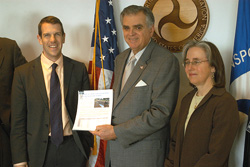Report on Roland Park's Sunday Streets pilot: 25 October 2009
26 November 2009
Report on the 25 October 2009 Roland Avenue Sunday Streets pilot
Prepared by
Mike McQuestion, co-Chair, Sustainability Initiative (mike.mcquestion@gmail.com)
Phil Spevak, President (pjspevak@gmail.com)
Roland Park Civic League
Background
Through its Sunday Streets Program, the City of Baltimore proposes to close off selected streets to motorized traffic during Sunday mornings, making them available for recreational use. Sunday Streets is modeled on Bogota, Colombia’s ciclovia. Every Sunday, from 8AM until 1PM, a network of normally busy Bogota streets is closed to motorists, allowing up to 1.7m residents to traverse the city on bicycles, rollerblades, skateboards or on foot. Bogota’s ciclovia has operated weekly since the early 1980s, providing residents in 70% of the city’s neighborhoods with easily accessible recreational opportunities. The idea is catching on. European examples include Copenhagen and Paris. In Switzerland’s Slow Up Program, 35-50km segments of particularly scenic roads are closed on consecutive Sundays during the summer months for pedestrians, skaters and cyclists to use. At this writing, 38 cities in eleven countries have organized ciclovias. Routes range from 1 to 121 km in length. Duration of ciclovia events ranges from 2 to 12 hours. The number of events ranges from 18 to 64 per year. Annual budgets range from US$45k to US$2.08m. In Seattle WA, Cambridge MA, San Francisco CA and El Paso TX, ciclovias happen at least every month during the cycling season. Ciclovia programs are credited with improving physical fitness, engaging young people in constructive social activities and increasing neighborhood cohesiveness (Sarmiento et al 2008).
Sunday Streets is an integral part of Baltimore’s 2009 Sustainability Plan.
The City’s street network is particularly conducive to Sunday Streets. (For more on this, see Baltimore’s 2006 Master Bicycle Plan.
City planners prepared a detailed Sunday Streets implementation plan nearly three years ago. The plan identifies specific streets and outlines logistic and security procedures for the Police and Transportation Department to follow. However, it has never been implemented, ostensibly for budgetary reasons.
Supporters of Baltimore’s Sunday Streets Program include the local bicycling advocacy group One Less Car. In 2008, One Less Car developed a 5-mile Sunday Streets pilot route which runs from Lake Montebello to Druid Hill Park along 33rd Street. This “lake-to-lake” pilot, proposed for August 2008, was not implemented, again for budgetary reasons (see below).
On October 25, 2009, a modest, one-mile long Sunday Streets pilot was carried out successfully on Roland Avenue, sponsored by the Roland Park Civic League. Details of that experience are described below. Most notably, the activity was successfully executed from plan to completion in 8 weeks.






